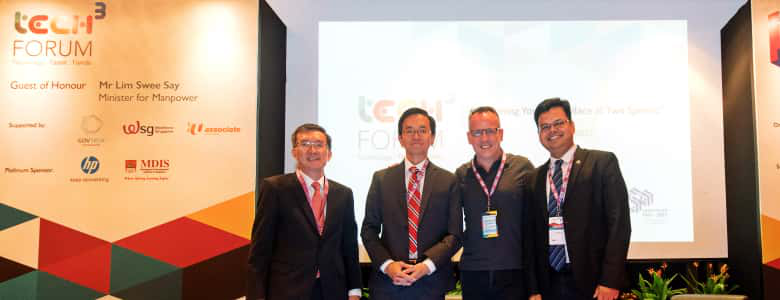Running fast, running slow

Imagine a property developer adding new facilities to an old office building.
It’s business as usual, but walls are going to be knocked down, an elevator is going to be completely offline and everyone will have to use the toilets in the building next door.
This contentious situation is analogous to the mix of legacy and agile approaches in software development today.
The old office building is akin to software in legacy format, while the new facilities are agile developments overlaid on the older structure.
These are known as the ‘two speeds’ of digital infrastructure, and modern businesses are still figuring out how best to operate in this dual-mode environment, said a panel of experts at the Singapore Computer Society’s (SCS) Tech3 Forum, held at the Mandarin Orchard Singapore on 12 July 2017.
Entitled ‘Running Your Workplace at Two Speeds’, the panel was moderated by Mr Vivek Kumar, Assistant Director-General at the National Trades Union Congress (NTUC).
Mr Tan Eng Pheng, Senior Director of the Government Technology Agency of Singapore’s (GovTech) Clusters Group was on the panel, along with Mr Richard Koh, Country Manager for Singapore and Thailand at Red Hat; and Mr Jordan Dea-Mattson, Vice President of Engineering at Carousell.
Dealing with dual modes
Businesses face immense pressure to provide consistent value while adapting rapidly to remain relevant.
Hence, working in two modes has its advantages: legacy software lends itself well to scale and stability, whereas agile developments, as the name suggests, are modular and allow responsiveness to changing needs.
But there are challenges to running a business at two speeds.
“The two working together sounds like the best of both worlds,” said Mr Kumar. “But it’s been said that when things sound too good to be true, perhaps they are too good to be true.”
The main pitfall: complexity. Legacy and agile approaches differ in the quality, design and architecture of their code and data.
When agile developers attempt to interface with legacy systems, they often run into problems such as inconsistent naming conventions and data referencing issues.
Operating at two speeds may therefore be more trouble than it’s worth.
“There are many benefits of operating in a single mode. Having two modes means that each team has a lot to learn from the other, and learning takes time,” said Red Hat’s Richard Koh.
However, Mr Koh conceded that given enough time to integrate, the teams may start to complement each other and become viable.
Mr Dea-Mattson, however, challenged the entire premise of two speeds, advocating for software engineers to return to the basic, empirical nature of software development.
“An empirical process is transparent and open to inspection, and you need to regularly inspect and adapt based on that information,” he explained.
“This approach is applicable to every project — you can use stepwise refinement to get to where you want to be.”
Mr Tan Eng Pheng elaborated that the methodologies, whether waterfall or agile, should be fit-for-purpose with the end goal in mind, to deliver quality systems and better user experience.
Developing deep competence
As competition for talent in the information technology sector heats up, the prospect of working in a two-speed organisation may seem less attractive.
Mr Koh pointed out that agile organisations are getting significantly more attention than those operating in legacy environments.
“This will attract the younger crowd, the more adventurous and creative ones,” he said.
“But any organisation operating in dual mode must understand that both teams are equally important for survival and success.”
Nonetheless, in a results-driven society, people naturally gravitate to what is successful.
The two speeds system, therefore, must first be seen as a viable working model before talent comes knocking.
“The government has set up a Digital Service Accelerator Programme to improve the design of front-end systems with high transaction volume, as part of its Digital Government push. External focus groups were conducted to determine end users’ needs and ensure good experience, while leveraging the established backend systems for processing,” said GovTech’s Mr Tan
This, he added, has helped to motivate other agencies to come onto the bandwagon.
Mr Tan also highlighted that the two-speeds mode of operations is just another step in the evolution of technology — to which people will eventually adapt.
“One important part of professional development is the constant up-skilling of our workforce’s technical expertise to remain relevant,” he said.
Delightful for end users
The panel’s consensus is that no matter which speed companies choose to operate at, user experience remains a top priority.
Software developers should thus strive for ‘user delight’, said the experts.
“It goes back to the philosophical question of ‘if a tree falls and no one is around to hear it, did it really happen?’ If there’s no one using that software, did you really just spend six months building it?”asked Mr Dea-Mattson, emphasising that software ought to be built for a purpose.
Noting that an internally-conflicted team may produce a sub-optimal result that mars the user experience, Mr Koh emphasised the importance of open communications.
“At Red Hat, we have an open decision framework which starts with the engagement of different stakeholders. We share with each other the core of the problem we’re trying to solve, understand the constraints we are working under, and together define what a successful outcome is.”
Agreeing, Mr Tan said that a consultative approach is also important when it comes to developing software for the diverse needs of the public sector.
Some of the collaborative projects that have benefited from greater engagement with the stakeholders and end users of the systems include the Immigration and Checkpoint Authority’s APPLE, the Ministry of Manpower’s Foreign Domestic Worker project, and the Ministry of Education’s Parents’ Gateway.
Mr Tan said: “Needs vary according to whether it’s an information query or a passport application, for example, and we need to adjust in consultation with stakeholders to provide a delightful experience.”
Photo credit:
- Main image (top photo) of panel members courtesy of SCS.

